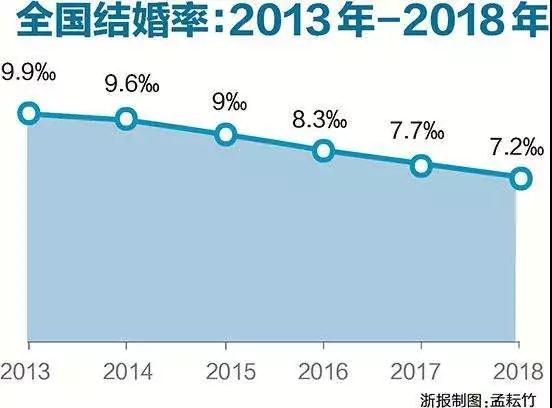“晚婚不婚”上热搜,结婚率连跌5年,这届年轻人为啥不爱结婚了?
中国日报双语新闻微信 2019-04-07 09:00

最近,“晚婚不婚成流行”上了热搜,引发网友广泛讨论。

微博上,该话题的阅读量已经达到4.7亿,讨论超8万。
而在中新社题为“晚婚不婚成流行,这届年轻人怎么了?”帖文下,有网友调侃称“这届年轻人想开了”。


据报道,根据国家统计局和民政部的数据,2018年全国结婚率为7.2‰,为2013年以来的最低。
2013年全国结婚率为9.9‰,2014年降低为9.6‰,2015年为9‰,2016年降到8.3‰,2017年再降到7.7‰,2018年中国结婚率只有7.2‰,全国结婚率连续5年下降。

Last year, the marriage rate nationwide dipped to 7.2 newly wedded couples per 1,000 people, dropping for the fifth consecutive year, according to the National Bureau of Statistics and the Ministry of Civil Affairs.
The rate stood at 9.9 per 1,000 in 2013, and was 7.7 in 2017.
另外,结婚率也出现了明显的地域差异。从各省市自治区来看,经济越发达结婚率越低。
2018年末,上海、浙江的结婚率为全国倒数前两名,上海结婚率为4.4‰,全国最低。
另外,天津、广东、北京等发达地区结婚率也较低。
The marriage rate is relatively low in China's most developed regions. For example, as of the end of last year, in Shanghai only 4.4 people out of every 1,000 people married in the year, the lowest rate in the country. Tianjin, Guangzhou, and Beijing also recorded low marriage rates.
结婚率最高的几个地区是西藏、青海、安徽、贵州等发达程度较低的地区。贵州2018年结婚率达到11.1‰,全国靠前。全国结婚率最高和最低的地区,这一数据相差一倍多。
Conversely, the marriage rate was notably higher in the country's relatively underdeveloped regions, such as Tibet, Anhui, and Guizhou. Guizhou's marriage rate was the nation's highest, at 11.1 per 1,000 people in 2018.
年轻人为什么不爱结婚了
结婚率连年下跌,为何会出现这一现象?专家学者们分析了以下几个原因。
1社会经济越发达,结婚率越低
从这次的数据可以看出,经济发达地区的结婚率都不高。
中国社会科学院社会发展战略研究院研究员葛道顺认为,这符合国际趋势:
The falling marriage rate and rising divorce rate in China reflect a global trend. For instance, in almost all OECD countries, the marriage rate has declined over the past few decades, according to an OECD report. And global experience shows socioeconomic development leads to a fall in the marriage and fertility rates.
中国结婚率走低和离婚率上升反映了一种国际趋势。比如,经济合作与发展组织的一份报告显示,几乎所有经合组织国家的结婚率都在过去几十年间有所下降。国际经验显示,社会经济的发展会导致结婚和生育率降低。
据《21世纪经济报道》报道,北京市委党校教授潘建雷认为,城镇化水平不断上升,进入城市的人越来越多,但是城市的生活节奏更快,经济压力也更大。
“同时,像北上广深这几个地方发展机会多,很多人为了要实现个人发展,结婚要推迟。因为生活压力大,缺爱的人也越来越多,目前来看这个情况不会有太大的逆转。”潘建雷说。
2社会老龄化,适婚人口比重减少
中南财经政法大学人口与健康研究中心主任石智雷指出,结婚率的下降与人口结构关系很大,随着老龄化的发展,结婚适龄人口的比重在相应减少,这必然会导致一般结婚率的下降。
最新数据也显示,结婚率的下降,还伴随着更低的出生率。
The birthrate was 10.94 per 1,000 on the Chinese mainland last year, down from 12.43 in 2017, the bureau said.
国家统计局和民政部称,2018年大陆出生率为10.94‰,比2017年的12.43‰进一步下降。
上海金融与法律研究院研究员刘远举也表示:
The downturn in marriage rates is normal when considering the dwindling youth population, the main contributor to the trend.
考虑到年轻人口的减少,结婚率会下降便不奇怪了,这也是结婚率低的主要原因。
"Due to the demographic structure, the marriage rate is expected to decrease further," he said.
他说:“由于人口结构的变化,预计结婚率还会进一步下降。”

此外,适婚的年轻群体中,接受教育的时间越长,结婚年龄也会越晚。
Among young people of marriageable age, Liu said the longer periods of time people spend undergoing formal education have led to many to putting off marriage until later in life.
刘远举称,适婚的年轻群体中,由于接受正规教育的时间延长了,因此很多人的结婚年龄也相应推迟了。
3结婚成本增加
买房育儿等生活成本的上升也是年轻人不敢轻易结婚的原因之一(the soaring costs of housing and child rearing in cities have fueled a growing unwillingness to start families)。
南开大学人口学教授李建民认为:
The decline in the marriage rate is closely related to the rising cost of getting married, especially the staggeringly high housing prices in some big cities and the increasing betrothal money a bridegroom has to give to the bride's parents. Marriage has become an economic issue as much as a social issue.
结婚率下降与结婚成本的增加有着密切联系,尤其考虑到大城市高企的房价和高价的彩礼。如今结婚既是一个社会问题,也是一个经济问题。

4网络占据了情感空间
社会的多元化和社交媒体的发达也让年轻人有了更多可寄托情感的事物。
葛道顺认为:
The internet has had a big impact on people's interpersonal relations, marriage included.
互联网对婚姻关系等人际关系的影响也十分巨大。
With more time and emotions consumed on the internet, people's need for interpersonal attachment and real-life interactions are reduced.
人们在互联网上耗费的时间和情感越来越多,就越来越不需要人际间的情感联系和现实生活中的互动。
5女性结婚意愿降低
专家认为,结婚率下降的另一个原因是选择不结婚的人群比例在上升,尤其是女性。
南开大学教授原新表示,2015年全国30-34岁女性不结婚比例在6%左右,比1990年提高了10倍左右。
葛道顺分析称:
With society becoming more inclusive and open, marriage is no longer the only way a woman can gain social status and success. This, to a large extent, has prompted a growing number of women to opt for a late marriage, or not marrying at all.
随着社会越来越包容开放,婚姻已不再是女性获得社会地位和成功的唯一方式,这在很大程度促使更多女性选择晚婚甚至不婚。

《我的前半生》里唐晶的职业女性形象深入人心
美国国家公共电台(NPR)也报道称,中国结婚率的下跌是因为更多女性选择晚婚,尤其是受教育程度较高、经济独立的女性。
报道称,虽然在中国的总人口里男性人数比女性多,但在过去的二十年中,大学里的女性人数已超过男性,这也导致了更多女性选择晚婚。
That means more women have career trajectories they don't want to jeopardize by marrying and having children while they're in their 20s and 30s. They're marrying later, or not at all.
这意味着更多的女性有自己的职业轨迹,她们不希望在自己二三十岁的时候让婚姻和子女影响自己的职业生涯。她们选择晚婚,甚至不结婚。
trajectory: /trəˈdʒektəri/轨道、轨迹
编辑:左卓 唐晓敏
记者:刘建娜 李磊
综合来源:中国日报 中新社 21世纪经济报道等


















 英语点津微信
英语点津微信 双语小程序
双语小程序